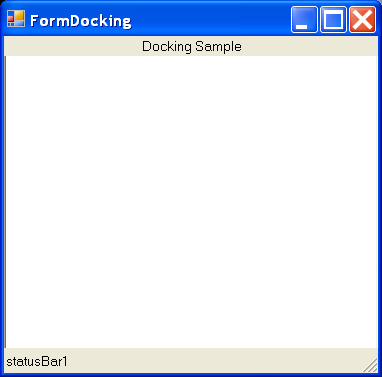Control Docking

/*
C# Programming Tips & Techniques
by Charles Wright, Kris Jamsa
Publisher: Osborne/McGraw-Hill (December 28, 2001)
ISBN: 0072193794
*/
using System;
using System.Drawing;
using System.Collections;
using System.ComponentModel;
using System.Windows.Forms;
using System.Data;
namespace Docking
{
/// <summary>
/// Summary description for FormDocking.
/// </summary>
public class FormDocking : System.Windows.Forms.Form
{
private System.Windows.Forms.StatusBar statusBar1;
private System.Windows.Forms.Label label1;
private System.Windows.Forms.TextBox textBox1;
/// <summary>
/// Required designer variable.
/// </summary>
private System.ComponentModel.Container components = null;
public FormDocking()
{
//
// Required for Windows Form Designer support
//
InitializeComponent();
//
// TODO: Add any constructor code after InitializeComponent call
//
}
/// <summary>
/// Clean up any resources being used.
/// </summary>
protected override void Dispose( bool disposing )
{
if( disposing )
{
if (components != null)
{
components.Dispose();
}
}
base.Dispose( disposing );
}
#region Windows Form Designer generated code
/// <summary>
/// Required method for Designer support - do not modify
/// the contents of this method with the code editor.
/// </summary>
private void InitializeComponent()
{
this.statusBar1 = new System.Windows.Forms.StatusBar();
this.textBox1 = new System.Windows.Forms.TextBox();
this.label1 = new System.Windows.Forms.Label();
this.SuspendLayout();
//
// statusBar1
//
this.statusBar1.Location = new System.Drawing.Point(0, 253);
this.statusBar1.Name = "statusBar1";
this.statusBar1.Size = new System.Drawing.Size(292, 20);
this.statusBar1.TabIndex = 9;
this.statusBar1.Text = "statusBar1";
//
// textBox1
//
this.textBox1.Dock = System.Windows.Forms.DockStyle.Fill;
this.textBox1.Multiline = true;
this.textBox1.Name = "textBox1";
this.textBox1.Size = new System.Drawing.Size(292, 273);
this.textBox1.TabIndex = 2;
this.textBox1.Text = "Top Bottom Left Right";
//
// label1
//
this.label1.Dock = System.Windows.Forms.DockStyle.Top;
this.label1.Name = "label1";
this.label1.Size = new System.Drawing.Size(292, 16);
this.label1.TabIndex = 10;
this.label1.Text = "Docking Sample";
this.label1.TextAlign = System.Drawing.ContentAlignment.MiddleCenter;
//
// FormDocking
//
this.AutoScaleBaseSize = new System.Drawing.Size(5, 13);
this.ClientSize = new System.Drawing.Size(292, 273);
this.Controls.AddRange(new System.Windows.Forms.Control[] {
this.label1,
this.statusBar1,
this.textBox1});
this.Name = "FormDocking";
this.Text = "FormDocking";
this.ResumeLayout(false);
}
#endregion
/// <summary>
/// The main entry point for the application.
/// </summary>
[STAThread]
static void Main()
{
Application.Run(new FormDocking());
}
}
}
Related examples in the same category